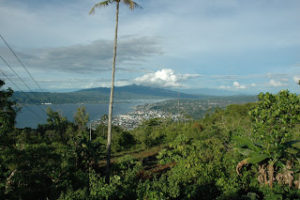The Indonesian archipelago has a rich diversity of languages. Several varieties of Malay are spoken in the area including the official language of Indonesia, Bahasa Indonesia, and Manado Malay, spoken in Northern Sulawesi. Another variety is Ambon Malay, a Malay creole spoken on Ambon and surrounding islands collectively known as Maluku (the Moluccas) or the Spice Islands. Arab traders and Muslim missionaries brought Malay to the islands in the fourteenth century.
In the early sixteenth century, the Portuguese arrived bringing their language and Catholic religion with them. By the time that the Dutch arrived at the turn of the seventeenth century, there were two languages of wider communication in the islands, Malay and Portuguese. After ejecting the Portuguese in 1605 the Dutch East India Company (VOC) established a base at Ambon. They made two attempts to introduce their language to the local people. In 1607 they established a school and taught in Malay and Dutch. However, by 1615 it was clear that these attempts were making little headway, in part because local people found Dutch a difficult language. Another attempt to introduce Dutch was made in the 1620s, using Malay as the medium of instruction. However, these efforts too eventually foundered and in 1665 the VOC decided it would no longer promote the use of Dutch among the inhabitants of Maluku. Another reason why Dutch was not adopted by local people was that although the Dutch had managed to dislodge Portuguese as an LWC, they could not or did not do so with the other pre-existing LWC, Malay. Despite this, as Nicoline van der Sijs has written, as a result of the continued presence of the Dutch in the area, there are some 570 Dutch loanwords in Ambon Malay. Among these are ambtenaar (official), belasting (tax) and jaloers (jealous). Other varieties of Malay spoken in Maluku such as Ternate Malay and Bahasa Indonesia also have plenty of Dutch loanwords.
Further reading:
Nicoline van der Sijs, Nederlandse woorden wereldwijd. The Hague: SDU, 2010, pp. 47-48.
Kees Groeneboer, ‘The Dutch Language in Maluku’, Cakalele, Maluku Research Journal Majalah Penelitian Maluku, 5 (1994), pp. 1-10.
François Valentijn, Omstandig Verhaal van de Geschiedenissen en Zaaken het kerkelyke ofte den Godsdienst betreffende, zoo in Amboina, als in alle de Eylanden […] (Amsterdam: Joannes van Braam, 1726), pp. 2-44.
Dit stukje verscheen eerder op het blog The History of Dutch.

Laat een reactie achter